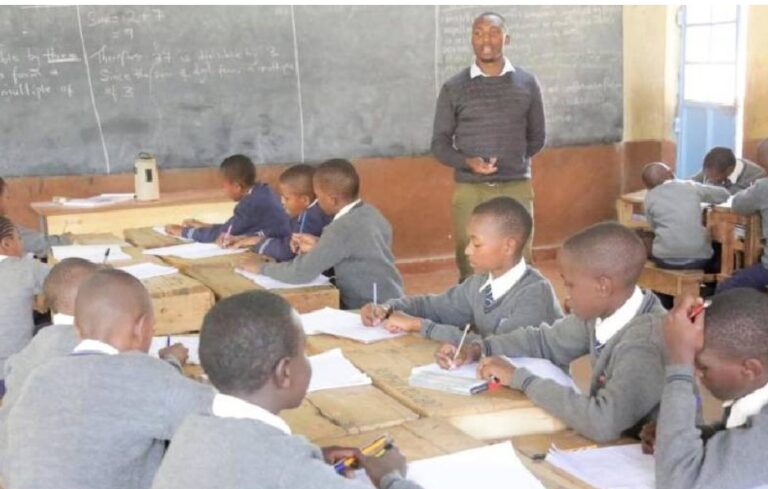Bad News Announced To All BOM Teachers. According to a recent study, eight out of ten teachers who work for school boards of management (BOM) receive a monthly wage of less than Sh10,000.
According to the Usawa Agenda 2023 study, which was issued on Thursday and is titled Foundation Literacy and Numeracy Assessment (FLANA), two out of every ten BoM teachers make between Sh10,000 and Sh20,000 per month.
According to Emmanuel Manyasa, executive director of Usawa Agenda, most schools struggle to raise funds and must look for other ways to guarantee that teachers in the BoM get compensated.
Parents can’t always provide financial support for their children’s instructors, so the government need to think about doing so. Parents around the country provide the funding source for BoM teachers, according to Dr. Manyasa, who made the announcement at the Kenya Institute of Curriculum Development offices in Nairobi.
The report also states that one in 100 BoM teachers earns between Sh20,000 and Sh30,000 monthly.
Bad News Announced To All BOM Teachers
“In rural areas, Sh70 out of Sh100 paid to BoM teachers is from parents while schools have to scrap Sh6.7 in every Sh100 from government capitation to pay the BoM teachers,” he stated.
“At least Sh7 in Sh100 paid to BoM teachers in rural areas come from government capitation and Sh6.2 in Sh100 paid to BoM teachers in urban areas come from government capitation.”
At the same time, the report showed one in 10 public and three in 100 private schools had at least one incident of children sitting on the floor.
“Private schools generally have better facilities than public schools. Urban schools generally have better facilities than rural schools. Seven in 10 public and nine in 10 private schools are fully fenced,” he said.
The report also showed that two in 10 public and seven in 10 private schools are partially fenced while 14 in 100 public and five in 100 private schools are not fenced.
On class sizes, Manyasa said they are consistently smaller in private compared to public schools.
An average Grade Seven class in a private school has less than a third of the number of learners in a similar class in a public school.
“Both rural and urban schools have almost constant number of streams across all the grades/class, which may indicate high retention rate. Urban schools have more streams than their rural counterparts at all levels,” the report states.
The report has also shown the percentage of school-aged children, aged six to 15 years and out of school has increased from 7.5 per cent in 2021 to 8.5 per cent in 2023.
Seven counties with the largest percentage of out-of-school children are all in the Arid and Semi-Arid Lands (ASAL) region with Mandera leading in the percentage of children out of school.
The other six counties are Marsabit, Turkana, Samburu, West Pokot, Tana River and Wajir.
“Worryingly, the majority of the children out of school are from households whose heads have no formal education. The assessment also found that a school-aged child in a poor household is twice as likely out of school as his/her counterpart in a rich household,” stated Manyasa.
It also showed four in 10 of children who dropped out of school last year cited lack of school fees.
The findings are a result of an assessment of foundational literacy and numeracy skills for children aged six to 15 years conducted between June and July last year by Usawa Agenda.
Bad News Announced To All BOM Teachers
In 2021, another of their report indicated that three out of 10 children were enrolled in private primary schools, but that changed significantly last year, with at least two out of 10 being enrolled in private schools.
The report however found that the children enrolled in private schools have better learning outcomes than those in public schools in both English literacy and numeracy.
“The odds for a learner in a private primary school to have better learning outcomes in English and numeracy are 45 per cent and 28 per cent respectively higher than those of a learner in a public primary school,” the report found.
In other findings, Manyasa said the assessment also found that nationally, only four out of 10 Grade 4 learners at least meet expectations in both solving a Grade 3 appropriate numeracy problem and reading a grade 3 appropriate English text.
Similarly, three in 10 Grade 4 learners in public schools and 5 in 10 Grade 4 learners in private schools at least meet expectations in both solving a Grade 3 appropriate numeracy problem and reading a grade 3 appropriate English text.
It also showed three in 10 Grade 6 learners did not meet expectations in reading a Grade 3 appropriate English text.
The survey also found that 77 per cent of teachers in public schools are employed on permanent and pensionable terms by Teachers Service Commission (TSC), 14 per cent are employed by the BoM while 9 per cent are interns under the Commission.
The report has also shown that 74.8 per cent of parents want the cost of the Competency-Based Curriculum (CBC) lowered, another 5.3 per cent said there is need to reduce learning areas, 4.2 per cent called for a reduction in homework given to children while 8.2 per cent of them said there is need to post enough teachers to implement the curriculum.
In a similar vein, 18.4% more respondents claimed that CBC consistently involves parents in their children’s educational activities, 21% said that the material is excellent, 39.1% stated that there are lots of practical activities, and 8% mentioned that the kids appear to be having fun.
Bad News Announced To All BOM Teachers
The report also showed that the KCPE mean score is unaffected by the bachelor’s degree held by four out of ten head teachers, five out of ten male head teachers, and four out of ten female head teachers.
